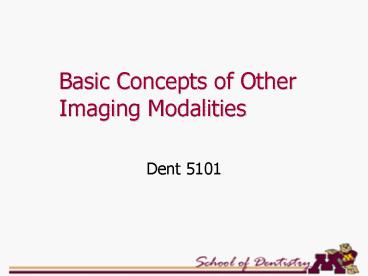Basic Concepts of Other Imaging Modalities - PowerPoint PPT Presentation
1 / 41
Title:
Basic Concepts of Other Imaging Modalities
Description:
Tube and film move in opposite direction, and rotate about a fulcrum. The level of the fulcrum is the focal plain. Blurring. Determined by: Distance of the tube travel ... – PowerPoint PPT presentation
Number of Views:733
Avg rating:3.0/5.0
Title: Basic Concepts of Other Imaging Modalities
1
Basic Concepts of Other Imaging Modalities
- Dent 5101
2
Body-section Radiography
- A special radiographic technique that blurs out
the shadows of superimposed structures - Object of interest less blurred
- Does not improve the sharpness
3
Tube and Film Move in Opposite Direction
4
(No Transcript)
5
- Tube and film move in opposite direction, and
rotate about a fulcrum - The level of the fulcrum is the focal plain
6
Blurring
- Determined by
- Distance of the tube travel
- Distance from the focal plain
- Distance from the film
- Orientation of tube travel
7
Types of Tomographic Motions
Linear
Circular
Elliptical
Trispiral
Hypocycloidal
Figure 8
8
Panoramic Radiography
9
Panoramic Radiography
- Obtained by rotating a narrow beam of radiation
in the horizontal plane - The film is rotated in the opposite direction
while the object (jaws) is stationary
10
(No Transcript)
11
Focal Trough
- A 3-dimensional curved zone or image layer in
which structures are reasonably well defined.
12
Types of Panoramic Machines
- Panorex Two centers of rotation. Interruption
of exposure in the midline - Orthopantomogram Three centers of rotation.
Continuous image
13
Panorex Image
14
Orthopantpmograph
15
(No Transcript)
16
Image Intensification
17
Early Fluoroscopy
- Early fluoroscopy done by direct observation
- Screen was poorly illuminated - image perception
inadequate
18
Image Intensification
- Image intensifier improved viewing of fluoroscopy
19
Intensifier Tube
- Four parts
- Input phosphor and photocathode
- Electrostatic focusing lens
- Accelerating anode
- Output phosphor
20
Intensifier Tube (Cont.)
- Input phosphor cesium iodide (CsI) or
zinc-cadmium-sulfide. - Photocathode A photo-emissive metal.
- Electrostatic focusing lens series of
negatively charged electrodesfocuses the
electron beam. - Output phosphor Provides thousand-fold more
light photons.
21
Intensifier Tube
- Used in
- Sialography
- Arthrography
22
Digital Imaging
23
Digital Imaging
- Conventional film-intensifying screen radiograph
- analog image. - Digital radiographfilm-less.
- Conventional films can be digitized, with a
likelihood of loss of information.
24
Photostimulable Phosphor (PSP)
- Storage phosphor
- Indirect Digital Radiography
- Similar to the intensifying screen phosphors
- Difference - PSP traps a significant number of
electrons in its phosphor, which is later read by
a laser beam
25
Photostimulable Phosphor (PSP)
26
(No Transcript)
27
(No Transcript)
28
(No Transcript)
29
Charge-coupled Devices
- An amorphous silicon wafer containing an array of
pixels (picture elements) - Each pixel acts as a capacitor storing charge
- On radiation exposure, electric charge is
deposited in the pixels proportional to the
intensity of the beam - The variation in charge deposition can be
digitally converted to an image
30
Pixels
- Each square (pixel) has its own color (numerical
value)
31
(No Transcript)
32
Pixel Array
33
CMOS
- Complimentary Metal Oxide Semiconductor
- Principle similar to CCD
- Simpler circuit design
34
CCD, CMOS
35
Resolution
- Ability to identify two different objects that
are close to each other - D-speed films gt10 line pair/mm
- Digital images7-10 line pair/mm
- Eyes 4-6 line pair/mm
36
Digital Subtraction
- Shows changes in an area over time
- Requires two films exposed with similar geometry
37
Digital Subtraction
- Two radiographs are obtained
- Identical position
- One superimposed over another
- Differences in two images identified digitally
- Allows identifying changes in hard tissue that
occurred between the two examinations
38
Radiation Dose
39
Image Processing/Reconstruction
- To improve diagnostic accuracy
- May improve the diagnosis of one disease, while
obscure another - Fraud
40
Digital Radiography Advantages
- Instant images
- Consistent quality
- High signal/noise ratio
- Image Manipulation
- Lower radiation dose
41
Disadvantages
- Lower resolution
- Quality depends on monitor and printer
- Print quality often not optimal
- Higher initial cost
- Unwanted manipulation of images

